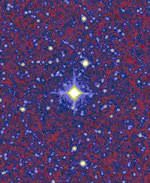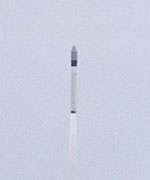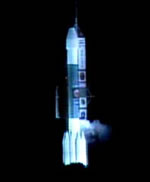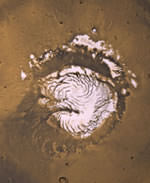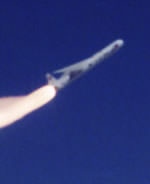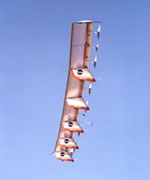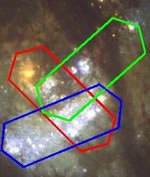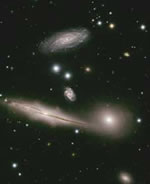
Image credit: Gemini
Thanks to its adaptive optics system and new imaging spectrograph, the Gemini observatory in Chile is producing images that rival those taken by the Hubble Space Telescope. One image of the Hickson Compact Group 87 (HGC87), a group of galaxies located 400 million light years away in the constellation of Capricornus, looks identical to that taken by Hubble. The seven-metre Gemini South is still being tested, but it’s expected to begin scientific operations in August, 2003.
Gemini Observatory’s new imaging spectrograph, without the help of adaptive optics, recently captured images that are among the sharpest ever obtained of astronomical objects from the ground.
Among the images and spectra acquired during recent commissioning of the Gemini Multi-Object Spectrograph (GMOS) on the 8-meter Gemini South Telescope, one image is particularly compelling. This Gemini image reveals remarkable details, previously only seen from space, of the Hickson Compact Group 87 (HCG87). HCG87 is a diverse group of galaxies located about 400 million light years away in the direction of the constellation Capricornus. A striking comparison with the Hubble Space Telescope Heritage image of this object, including resolution data, can be viewed at http://www.gemini.edu/media/images_2003-3.html.
“Historically, the main advantage of large ground-based telescopes, like Gemini, is their ability to collect significantly more light for spectroscopy than is possible with a telescope in space,” said Phil Puxley, Associate Director of the Gemini South Telescope. He explains, “The Hubble Space Telescope is able to do things that are impossible from the ground. However, ground-based telescopes like Gemini, when conditions are right, approach the quality of optical images now only possible from space. One key area – spectroscopy of faint objects, which requires large apertures and fine image quality – is where large telescopes like Gemini provide a powerful, complementary capability to space-based telescopes.”
GMOS-South is currently undergoing commissioning on the 8-meter Gemini South Telescope at Cerro Pach?n, Chile. “GMOS-South worked right out of the box, or rather, right out of the 24 crates that brought the 2-ton instrument to Chile from Canada and the UK – just like its northern counterpart did when it arrived on Hawaii’s Mauna Kea,” says Dr. Bryan Miller, head of the commissioning team. “The GMOS program demonstrates the advantage of building two nearly identical instruments. Experience and software from GMOS-North have helped us commission this instrument more rapidly and smoothly than we could have done otherwise,” explains Dr. Miller. He adds, “Although the images from GMOS-South are spectacular, the instrument is primarily a spectrograph and that is where its capabilities are most significant for scientists.” GMOS-South is expected to begin taking science data in August 2003.
As a multi-object spectrograph, GMOS is capable of obtaining hundreds of spectra in one “snapshot.” The ability to deliver high-resolution images is a secondary function. “It used to take an entire night to obtain one spectrum,” explains Dr. Inger J?rgensen, who led the commissioning of the first GMOS instrument on the Frederick C. Gillett Gemini Telescope (Gemini North) over a year ago. “With GMOS, we can collect 50-100 spectra simultaneously. Combined with Gemini’s 8-meter mirror, we are now able to efficiently study galaxies and galaxy clusters at vast distances – distances so large that the light has traveled for half the age of the Universe or more before reaching Earth. This capability presents unprecedented possibilities for investigating how galaxies formed and evolved in the early Universe.”
GMOS achieves this remarkable sensitivity partly because of its technologically advanced detector, which consists of over 28 million pixels, and partly because of multiple innovative features of the Gemini dome and telescope that reduce local atmospheric distortions around the telescope. “When we designed Gemini, we paid careful attention to controlling heat sources and providing excellent ventilation,” said Larry Stepp, former Gemini Optics Manager. Stepp elaborates, “For example, we constructed 3-story-high vents on the sides of the Gemini enclosures. It is great to see this image that provides such a dramatic validation of our approach.”
“The twin Gemini Telescopes offer a unique advantage,” explains Director of the Gemini Observatory Dr. Matt Mountain. “Now that both telescopes are equipped with nearly identical GMOS instruments, we have created an unprecedented uniform platform to coherently study and take deep spectra of any object in the northern or southern sky at optical wavelengths.”
Upgrades to GMOS-South that will increase its variety of capabilities are planned even as the instrument is undergoing commissioning. An Integral Field Unit (IFU) on GMOS-South is anticipated to begin commissioning in early 2004. Jeremy Allington-Smith, leader of the IFU team at the University of Durham said, “GMOS-South will soon be fitted with an integral field unit like its sister on Gemini North. Made by the University of Durham, it uses more than a thousand optical fibers, tipped at each end with microscopic lenses, to dissect the object under study. This gives GMOS a 3-D view of the target, in which each pixel in the image is replaced by a spectrum. This innovation allows GMOS to make detailed maps of, for example, the motion of stars and gas in galaxies.”
GMOS was built as a joint partnership between Gemini, Canada and the UK. Separately, the U.S. National Optical Astronomy Observatory provided the highly capable detector subsystem and related software (http://www.noao.edu/usgp). It is anticipated that GMOS-South will be available for full scientific operations in August 2003 when astronomers from the seven-country Gemini partnership will begin using the instrument for a wide variety of scientific studies.
The Gemini Observatory is an international collaboration that has built two identical 8-meter telescopes. The Frederick C. Gillett Gemini Telescope is located at Mauna Kea, Hawai`i (Gemini North) and the other telescope at Cerro Pach?n in central Chile (Gemini South), and hence provide full coverage of both hemispheres of the sky. Both telescopes incorporate new technologies that allow large, relatively thin mirrors under active control to collect and focus both optical and infrared radiation from space.
The Gemini Observatory provides the astronomical communities in each partner country with state-of-the-art astronomical facilities that allocate observing time in proportion to each country’s contribution. In addition to financial support, each country also contributes significant scientific and technical resources. The national research agencies that form the Gemini partnership include: the US National Science Foundation (NSF), the UK Particle Physics and Astronomy Research Council (PPARC), the Canadian National Research Council (NRC), the Chilean Comisi?n Nacional de Investigaci?n Cientifica y Tecnol?gica (CONICYT), the Australian Research Council (ARC), the Argentinean Consejo Nacional de Investigaciones Cient?ficas y T?cnicas (CONICET) and the Brazilian Conselho Nacional de Desenvolvimento Cient?fico e Tecnol?gico (CNPq). The Observatory is managed by the Association of Universities for Research in Astronomy, Inc. (AURA) under a cooperative agreement with the NSF. The NSF also serves as the executive agency for the international partnership.
Original Source: Gemini News Release
